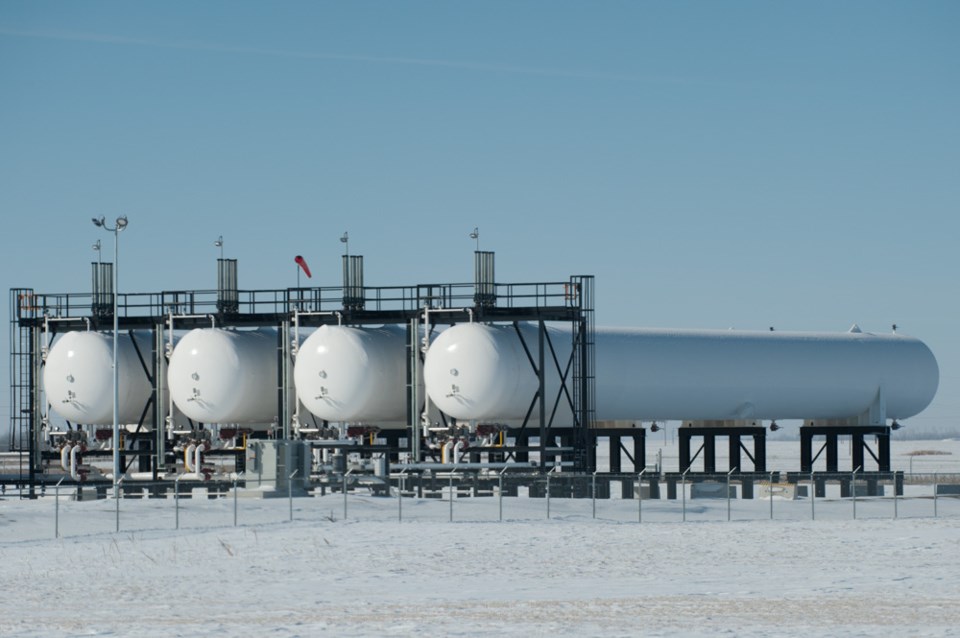“Let them freeze in the dark” is an old saying that got a lot of play in late November, as famously anti-pipeline, anti-oil, pro-equalization Quebec said on Nov. 21 it was within days of running out of propane due to the Canadian National Railway strike.
A few days later, it was announced a train was expected by Nov. 25 which would tide the province over for a few more days. On Nov. 24, , stating in a press release, “Pembina is preparing unit trains, comprising up to 105 cars, with propane sourced fromĚýWestern Canada, by Canadian producers at Pembina'sĚýRedwater, Alberta,Ěýfacility. Pembina's facility is the only one inĚýCanadaĚýcapable of amassing these quantities of propane and building such unit trains.”
So what’s this all about? I spent the morning of Nov. 25 doing a quick refresher. I write a lot about oil, but little about propane.
Propane is a natural gas liquid (NGL). It’s stripped out of raw natural gas that comes out of the well. This is done through a process call fractionation. In that sense, propane is a “natural gas” as well as other NGLs, but we generally think of methane when we refer to “natural gas,” so that’s how I’m going to refer to it here.
When raw natural gas flows out of a well, or is extracted as a byproduct of oil production (known as “associated gas production”), it goes to a gas plant where, depending on the complexity of the plant, the various NGLs are extracted. More complex plants extract more of the products, while less complex ones correspondingly leave some in the gas stream.
These days, “liquids rich” gas is all the rage. That’s because the shale revolution has collapsed the North American price for dry natural gas (methane) to a shadow of what it was 12 years ago. It’s remained that way ever since, and likely will for decades. At some points, the methane sells for damned near nothing. Recently there have even been instances in Alberta where gas producers have had to pay for clients to take their product, if you can believe it.
So the NGLs, including propane, is where it’s at, as a gas producer. Other NGLs include ethane (which, as ethylene, is a key component of plastics), butane (petrochemical feedstock), isobutane (refinery feedstock), pentane (gasoline) and pentanes plus (“natural gasoline”), according to the .Ěý
Where do you use propane? Basically, wherever you need a flame and there is a lack of natural gas infrastructure. In other words, no pipelines.
This includes remote communities, farmers drying grain, your barbecue in the backyard or the one you take to the lake. A few years ago, my dad converted his house on the farm from fuel oil (essentially diesel) to propane heat, resulting in a tremendous cost savings.
But I’ve also learned that sometimes propane is used to supplement natural gas supplies, where either there’s insufficient pressure or insufficient energy from the natural gas by itself. In these cases, propane is used in a mixed-fuel scenario.
There’s not a lot of pipe moving propane to Central Canada.
There once was a dedicated pipeline which carried propane from Alberta to central Canada, the Cochin Pipeline. Kinder Morgan owns it, but is in the process of selling it to Pembina. The Canada Energy Regulator (formerly National Energy Board) website notes, “The Cochin Pipeline commenced operations in 1979. Cochin originally moved products (solely propane in recent years) eastward from Fort Saskatchewan to Windsor, Ontario. In March 2014, the direction of flow on the segment of the Cochin Pipeline from Kankakee, Illinois, to Fort Saskatchewan was reversed to transport condensate westbound. The reversed pipeline started operations in July 2014.”
The eastern portion of that pipeline system now delivers ethane from Ohio to Windsor.
Enbridge’s Line 1 takes NGLs to Superior, Wisconsin, and then its Line 5 takes NGLs from there to Sarnia, Ontario.
These days, most propane, at least from Saskatchewan, is shipped by rail, with the rest by truck. A lot goes through the rail terminal at Northgate, on the U.S. border (conveniently on the BNSF Railway, not CN.)
This whole supposed crisis in Quebec leaves some interesting questions.
How does a province run so dangerously low of a critical fuel supply like propane? Was it the increased consumption by farmers trying to dry grain there, as well as on the prairies? Or was there some sort of market failure? And if it was, how and when did the government of Quebec step in? Why should governments have to ration supplies?
(Before you hurt your head on that last point, I was told that rationing happens quite frequently in some American states.)
Did some Brainiac think propane should be a just-in-time logistics case, instead of having sufficient reserves on hand to handle dips in supply?
As I pointed out in my column last week, Quebec does, indeed, have its own natural gas (which I imagine would include propane would make some of that). But the province won’t allow fracking, and therefore it is stuck in the ground. Will this episode perhaps change some minds in that regard?
We’re not at war right now, and the temperatures haven’t dropped to -40 C. There should be no reason a rail disruption should cause such potential turmoil in so few days.
Maybe it’s time for Quebec to start drilling, and fracking. Either that, or learn what life is really like without our “socially unacceptable” petroleum products.
Ěý
Brian Zinchuk is editor of Pipeline News. He can be reached at [email protected].
Ěý




